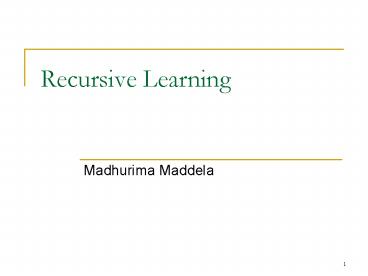Recursive Learning - PowerPoint PPT Presentation
Title:
Recursive Learning
Description:
Traditionally used to branch and bound in the search space to generate test ... J. M. Silva and L. G. e Silva, 'Solving satisfiability in combinational circuits ... – PowerPoint PPT presentation
Number of Views:79
Avg rating:3.0/5.0
Title: Recursive Learning
1
Recursive Learning
- Madhurima Maddela
2
Decision Tree
- Traditionally used to branch and bound in the
search space to generate test vectors - Inefficient for hard-to-detect and redundant
faults - Solution! Recursive learning
H. Fujiwara, T. Shimono, "On the Acceleration of
Test Generation Algorithms", 13th Intl. Symp. on
Fault TolerantComp., pp. 98-105, 1983.
3
The concept
- Decision tree looks for one successful solution
- Recursive learning looks for necessary conditions
to purge the non-solution area - Generates all the necessary assignments for a
given condition, very effective around indirect
implications. - Doesnt retrace the same path twice, backtracks
can be completely avoided - Can be called recursively, hence accounts for
completeness.
W. Kunz, HANNIBAL An Efficient Tool for Logic
verification Based on Recursive Learning, ICCAD,
pp. 538-543, 1993.
W. Kunz and D. K. Pradhan, Recursive Learning
Technique and Applications to CAD, US Patent
Application No. 08/263721
4
Fault Propagation using Recursive Learning
W. Kunz and P. Menon, Multilevel Logic
Optimization by Implication Analysis, Proc. Int.
Conj Computer-Aided Design (ICCAD), 1994.
5
Boolean Satisfiability (SAT)
- SAT widely used for Electronic Design Automation
(EDA) - Design formulation mapped using Conjunctive
Normal Form (CNF) - Can employ extensively validated algorithms
J. M. Silva and L. G. e Silva, Solving
satisfiability in combinational circuits with
backtrack search and recursive learning, XII
Symposium on Integrated Circuits and Systems
Design, pp,. 192-195, 2000.
6
Recursive learning on CNF formulae
J. M. Silva and L. G. e Silva, Solving
satisfiability in combinational circuits, IEEE
Design and Test of computers, pp. 16-21, 2003.
7
Performance
- Both perform the same for circuits with no
backtracks (like c1355, c5315) - Recursive learning
- No aborted faults
- Computation is faster
- Occasionally, recursion depth runs high
W. Kunz, D. K. Pradhan, "Recursive Learning A
Precise Implication Procedure and its Application
to Test Generation in Digital Circuits", IEEE
Trans. on Computer-Aided Design of integrated
circuits and systems, vol. 13, no. 9, 1994.
8
Summary
- Can be used in combinational as well as
sequential circuits - Works for different logic alphabets
- Identifies indirect implications
- Limiting factor - recursion depth, rmax
- Not necessary in circuits with easy-to-detect
solutions































